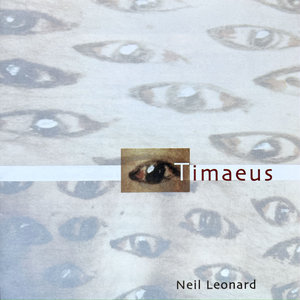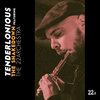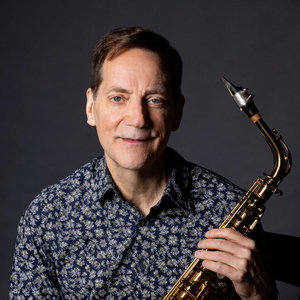Timaeus by Neil Leonard
Tracklist
| 1. | M87 | 5:27 |
| 2. | Timaeus I | 2:15 |
| 3. | Caxioinics | 7:34 |
| 4. | Sacred Bath I | 3:47 |
| 5. | Sacred Bath II | 6:48 |
| 6. | Sacred Bath III | 6:44 |
| 7. | Timaeus II | 4:49 |
| 8. | Legacy: San Lazaro | 10:38 |
| 9. | Inner Path | 3:53 |
| 10. | Passage | 7:40 |
Credits
released July 1, 2001
The music on this CD was recorded in real-time without the aid of overdubbing. All works composed, performed and programmed by Neil Leonard III, ASCAP, except Caxionics, by Neil Leonard and Ileana Perez, ASCAP.
M87 (1996) The computer 'listens' to my use of certain scale degrees and responds by creating a tapestry of melodic patterns in real-time.
Timaeus I (1999) is a study in automated improvisation using the Lydian Chromatic Concept. In "Timaeus I" the computer compresses and expands the intervals of prevailing mode so that it can be heard in the conventional way, spanning one octave, or gradually compressed to so that all the notes sound in unison.
Caxionics (1994) is organized into three continuous sections. A recording of processed tenor saxophone is heard throughout. The score includes interpreted and improvised sections for saxophone with live effects processing. The processed tape and score were composed by Ileana Perez Velazquez. The title is a blending of the words cancion, saxophone and electronics.
Timaeus II (1999) is a modal improvisation for saxophone and live electronics. Plato uses Timaeus' explanation to show how human perceptions, the body and the soul are linked to larger universal structures and how certain harmonious relationships exist on all levels.
Sacred Bath I, II, III (1993) is based on my electroacoustic soundtrack for the video "Baño Sagrado" by Maria Magdalena Campos-Pons. The drumming in the middle section is an algorithmic variation on a four bar pattern by Cuban percussionist Ernesto Rodriguez, whom I met while playing with Emiliano Salvador in Havana.
Legacy: San Lazaro (1989) was created and premiered at the Banff Center for the Arts and later performed at the International Computer Music Convention, Montreal. It automates certain approaches to rhythmic improvisation that I was introduced to while playing with Jymmie Merritt. The piece is dedicated to Sotero Campos.
Inner Path (1993) is a computer generated score for soprano saxophone. The Golden Mean was used to select intervals for the construction of melody.
Passage (1996) was written during an American Composers Forum residency. With the exception of the bass samples, all sound are synthesized in real-time. The tuning of the scales changes continually throughout the piece.
The music on this CD was recorded in real-time without the aid of overdubbing. All works composed, performed and programmed by Neil Leonard III, ASCAP, except Caxionics, by Neil Leonard and Ileana Perez, ASCAP.
M87 (1996) The computer 'listens' to my use of certain scale degrees and responds by creating a tapestry of melodic patterns in real-time.
Timaeus I (1999) is a study in automated improvisation using the Lydian Chromatic Concept. In "Timaeus I" the computer compresses and expands the intervals of prevailing mode so that it can be heard in the conventional way, spanning one octave, or gradually compressed to so that all the notes sound in unison.
Caxionics (1994) is organized into three continuous sections. A recording of processed tenor saxophone is heard throughout. The score includes interpreted and improvised sections for saxophone with live effects processing. The processed tape and score were composed by Ileana Perez Velazquez. The title is a blending of the words cancion, saxophone and electronics.
Timaeus II (1999) is a modal improvisation for saxophone and live electronics. Plato uses Timaeus' explanation to show how human perceptions, the body and the soul are linked to larger universal structures and how certain harmonious relationships exist on all levels.
Sacred Bath I, II, III (1993) is based on my electroacoustic soundtrack for the video "Baño Sagrado" by Maria Magdalena Campos-Pons. The drumming in the middle section is an algorithmic variation on a four bar pattern by Cuban percussionist Ernesto Rodriguez, whom I met while playing with Emiliano Salvador in Havana.
Legacy: San Lazaro (1989) was created and premiered at the Banff Center for the Arts and later performed at the International Computer Music Convention, Montreal. It automates certain approaches to rhythmic improvisation that I was introduced to while playing with Jymmie Merritt. The piece is dedicated to Sotero Campos.
Inner Path (1993) is a computer generated score for soprano saxophone. The Golden Mean was used to select intervals for the construction of melody.
Passage (1996) was written during an American Composers Forum residency. With the exception of the bass samples, all sound are synthesized in real-time. The tuning of the scales changes continually throughout the piece.








